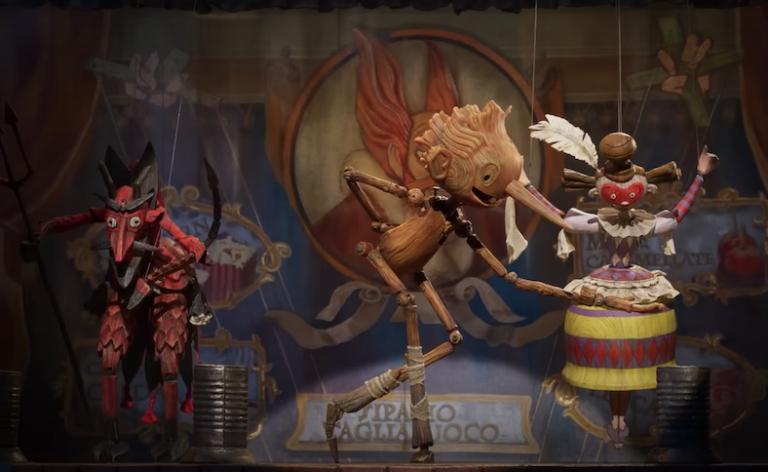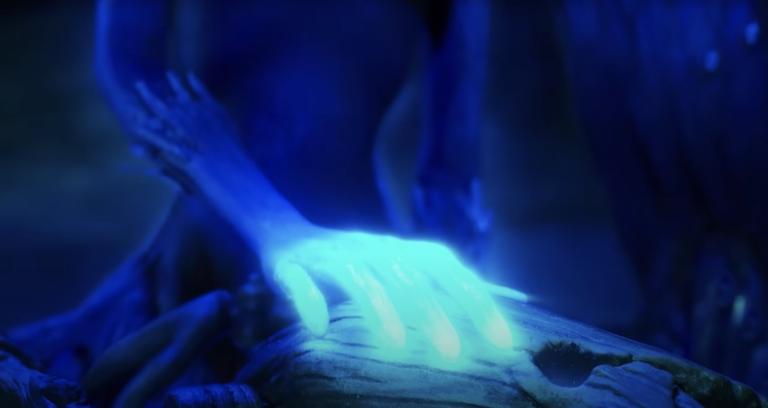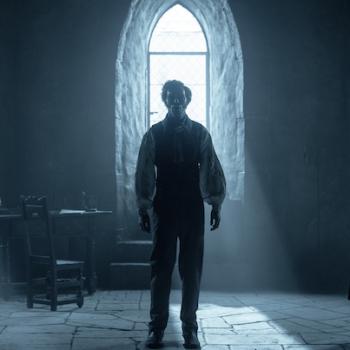
For a guy who sometimes claims to be an atheist, Guillermo del Toro sure spends a lot of time talking about faith.
Del Toro says he left the Catholic Church as soon as he could. And yet his breakout movie, Pan’s Labyrinth, could be read as something of a Catholic parable of sacrifice and redemption. He turns his back on faith, but his Hellboy movies presupposes heaven and hell, and its titular hero is the most unlikely Christian you can imagine.
With Pinocchio—a beautifully told take on a 140-year-old tale—we may have del Toro’s most religious movie yet. As with all good art, it sprinkles that religion with a healthy dose of ambiguity. With one hand, del Toro slaps down religion; with the other, he lifts it up.
Let me show you what I mean.

Wooden Hope
In the movie’s opening stanza, del Toro introduces us to the woodcarver Geppetto and his son, Carlo. The director takes pains to show viewers how pious Geppetto is: He and Carlo pray at the dinner table. A cross hangs over Geppetto’s bed. And in what may be the culmination of his woodcarving career, he’s carving a massive crucifix for the local cathedral—a sculpture made from a tree he himself cut down.
That Christ-adorned cross foreshadows much of the movie in several ways. But at this point, I only want to mention that Jesus—sans Geppetto’s blood-colored paint—almost looks as if he’s sleeping on the cross, not dead.
That’s potentially an interesting wrinkle. Because as Geppetto begins adding paint to his crucifix and Carlo watches from below, his Italian town—specifically the church—is struck by a bomb. (Most of the movie seems to take place during World War II.) The crucifix loses an arm, the roof is torn off, the entry loses a few stone angels—and most critically, Geppetto loses his son.
Geppetto slips into a deep depression. He prays fervently, apparently for Carlo to come back to him. He lets his work at the church slip, letting the crucifix sit in ruins. And finally, in a drunken rage, the woodcarver snaps.
“Why won’t you listen to my prayers?!” he shouts to the heavens. And he begins chopping down the tree that he himself planted—one, perhaps in another bit of foreshadowing, was planted to replace the tree that became the crucifix. He hauls that tree back to his workshop and, in a madness, Geppetto begins chopping and hacking and breaking and carving—slowly shaping a little wooden boy out of the Italian pine. And then he passes out.

When You Wish Upon a Star
The picture that del Toro gives us with Geppetto here is a man who has lost his faith. He’s furious with God. He neglects his church. And like a furious, desperate Dr. Frankenstein, he takes matters into his own hands. He crafts a thing in his own son’s image—a poor facsimile of the real thing. The act of creation feels almost diabolical, an act of rebellion against the divine order.
We could leave it at that, of course, and perhaps del Toro would like us to. His works often embrace a sense of rebellion, a love of the marginalized that have fallen out of how we think things should be. Organized religion here certainly doesn’t come across well: The priest we meet can be at times condemning, often ineffectual. And he seems to serve as a passive (but perhaps unwilling) sidekick to the village’s fascist leader. At best, the Church establishment feels rather ineffectual to make real change happen—to raise Geppetto’s blessed Carlo from the dead. God, it seems, is sleeping.
It’s left to another entity—called a wood sprite in the movie—to enact the change we all expect. It’s up to that sprite to imbue the wooden puppet with animation and life. To turn him into what we soon will call Pinocchio. When a cricket named Sebastian asks her who she is, she replies, “I care for the little things. The forgotten things. The lost ones.”
But this division between organized Christianity and the magical wood sprite aren’t, perhaps, as distinct as you’d think.

Better Angels of Our Nature
While del Toro has sometimes pitted older, wilder, more magical forces against church and state and normalcy, we should take a quick look at that wood sprite. The creature we see has multiple sets of wings. The lower set of wings seems to often cover the sprite’s feet. The upper pair, which grace the sides of her head, covers her face when she first materializes. And at least in the middle set of wings—the wings that would seem to do the literal heavy lifting—the wings are covered with eyes.
Now, let’s look at this description of a seraphim—the highest order of angels, according to Christian theology—in the biblical book of Isaiah:
“Above him stood the seraphim. Each had six wings: with two he covered his face, and with two he covered his feet, and with two he flew. (Isaiah 6:2)”
Ezekiel, another prophet from the Bible, alleges that another group of angels, the cherubim, were covered in eyes.
And Thomas Aquinas, the famous Catholic theologian, said that seraphim are all about charity—even the “excess of charity”—that burns within them like fire. That sense of charity seems to have an echo in the wood sprite’s declaration that she cares for “the little things … the lost ones.” Geppetto is most certainly lost in this moment. And bestowing animation (if not life) to Pinocchio is an act of upmost charity.
Now, del Toro is rightly famous for his cinematic creatures, but he’s a savvy filmmaker, and I don’t think it’s an accident that his wood sprite shares some commonality with biblical angels.

I Got No Strings
Let’s consider for a moment the dual nature of Pinocchio. His body was made in a fit of furious-at-God rebellion. The animative force within him seems more divine, even if it’s not exactly God-given life. In Pinocchio, then, you see in a way the war we all deal with: the fight of flesh (or in this case, wood) against the spirit.
In Galatians 5:17: Paul writes about this dynamic: “For the desires of the flesh are against the Spirit, and the desires of the Spirit are against the flesh, for these are opposed to each other, to keep you from doing the things you want to do.” And in the beginning, Pinocchio’s flesh clearly has the upper hand. He does exactly what he wants to do. When Geppetto and we first see him, he’s more monster than man, all because everything’s all about him. He sweeps through Geppetto’s workshop like a whirlwind and demands (ironically) to go to church.
When Sebastian Cricket—Pinocchio’s conscience—tells Pinocchio that he must obey, Pinocchio says simply, “I don’t want to obey!” and smashes the cricket flat (though the cricket makes a comeback).
The puppet does go to church—shocking the congregation something awful—eyes the still half-ruined crucifix and mimics Jesus hanging on the cross. It feels, in the moment, disrespectful, as if he’s mocking the Savior. But Pinocchio knows no better. He’s not been taught otherwise.
But in all of this, he’s mimicking us humans, too. He’s selfish as we are. We often don’t understand what Christ on that cross really means. We live, as Pinocchio does in that moment, for ourselves.
What changes that? Love.

The Greatest of These
I’m Christian, and we’re taught that love really begins and ends with God. He loved us, and so we have the ability to love others and hopefully return His love, too. And in the strain of Christianity that I belong to, we believe that we can’t work our way right with our Creator: We change our selfish ways through love. We’re motivated to do what’s pleasing in His eyes not through duty, but because we love. In the Bible, the love between Creator and created is often depicted as that between a father and child.
And so it is with Pinocchio. With help from his resilient conscience, Sebastian, and his growing love for Geppetto, the puppet grows throughout the movie to be more giving, more considerate and more sacrificial. At first, he doesn’t see the point of obedience. But when he begins to understand the concept of affection and family, he goes beyond obedience into a different realm wrapped up in the sort of love that the Greeks called agape—the giving, charitable love of God.
And through Pinocchio’s love, Geppetto learns to love again as well. When Geppetto made Pinocchio, he made him as a mimicry of his long lost “real” son, Carlo. But it’s not long before Geppetto begins to love Pinocchio for himself.
In del Toro’s hands, their relationship becomes one of unexpected poignancy, in part because both have to go through a lot of sacrifice and pain to understand both what love is and the love they have for each other. But that is the way of what Paul declared was the most powerful force imaginable. Writes C.S. Lewis about love:
Love anything and your heart will be wrung and possibly broken. If you want to make sure of keeping it intact you must give it to no one, not even an animal. Wrap it carefully round with hobbies and little luxuries; avoid all entanglements. Lock it up safe in the casket or coffin of your selfishness. But in that casket, safe, dark, motionless, airless, it will change. It will not be broken; it will become unbreakable, impenetrable, irredeemable. To love is to be vulnerable.
Near the end of the movie, the sprite revisits Geppetto and tells him that she only wanted to bring him joy.
“You did bring me joy,” Geppetto says. “Such terrible, terrible joy.”
And it’s through that terrible joy that life—real life—is found. (Caution, a few spoilers from here on out.)

Pining for More
Geppetto ultimately returns to his work, finishing and repairing the crucifix in the church. He never, it should be noted, loses his faith altogether: The cross remains hanging above his bed. And it seems that Pinocchio—as unholy as some in the church thought him to be initially—is a catalyst toward Geppetto returning to life, as it were.
But as Geppetto works and Pinocchio helps, the puppet is still fascinated by the man on the cross.
“Everybody likes him,” Pinocchio says, referring to the wooden Jesus. “They were all singing to him. He’s made of wood too. Why do they like him and not me?”
His first encounter with Jesus—when he goes to church without permission—comes across as mockery. But now, Pinocchio’s curious. And from here on out, del Toro purposefully turns Pinocchio into a Christ-like figure, albeit an imperfect one.
Pinocchio is taken to an overlook by the puppeteer, Count Volpe, who’s trying to get Pinocchio to join his troupe. “You shall see all the nations of the Earth as they bow at your feet!” Volpe declares—a clear allusion to Satan’s temptation of Christ in the wilderness.
Much later, Pinocchio is hung on a cross—facing execution. He even loses an arm, just like the wooden crucifix did in the bombing raid. Again and again, del Toro asks us to look at Pinocchio as a Christ-like being.
The fact that Pinocchio is, in a sense, immortal, only adds to the parallels.
Pinocchio “dies” several times in the movie. But he can’t really die, because he’s not really alive. The wood sprite animated his spirit, but that’s not the same as true God-given life. Death itself—a chimera-like creature living in a purplish land of sand—tells him that he’s simply “the wooden boy with a borrowed soul … you are not, nor will you ever be, a real boy, like Carlo.”
But that’s not altogether true.
Late in the movie, Pinocchio and Geppetto escape a giant, monstrous fish. But Pinocchio “dies” in the process and finds himself back in the land of Death. He has to wait a bit before he’s sent back—a little longer with each death, he’s told—but Pinocchio is desperate to return. Geppetto, see, is himself dying, drowning in the ocean. Pinocchio needs to get back now to save him.
Death tells him that he can go back early, but he’ll sacrifice his immortality to do so. “Rules are rules, and if you break them, there are dire consequences,” Death tells him.
But Pinocchio doesn’t care. He needs to get back to save his Papa. And in so doing, he lives. He becomes mortal. He becomes a real boy.

Of Splinters and Spirit
There’s two deeply spiritual tracks to make note of here.
First, the obvious. The director’s been pointing to Pinocchio as a Christ-like figure. One last time, Pinocchio returns to save the one he loves, and in so doing, breaks the rules.
God, too, broke the rules of the universe. He came to earth as a mortal. He not only lived, but He died. All because He loved us so much.
But if Pinocchio is, in del Toro’s hands, a curious Christ-like figure, I think he also feels like most of us, too.
Without love—a love that I believe begins and ends and has its highest manifestation in God—we are wooden. Without that willingness to truly love in that most painful of ways, we don’t really live. We may walk and talk and breathe. But to live requires something else. To live requires love.
The story of Pinocchio has been told and retold, imagined and reimagined, many times. But in del Toro’s hands, the story comes with added heft, added depth. Perhaps the agnostic/atheist del Toro imagined that he was giving us a more humanistic Christ-like figure, imploring us to turn away from Geppetto’s wooden cross.
But like Pinocchio, whose eyes are drawn toward that crucifix, I am drawn to the echoes of Christ I see here—those intended and those perhaps not. Regardless, Pinocchio is unquestionably a work that probes religion and faith. And that’s no lie.













